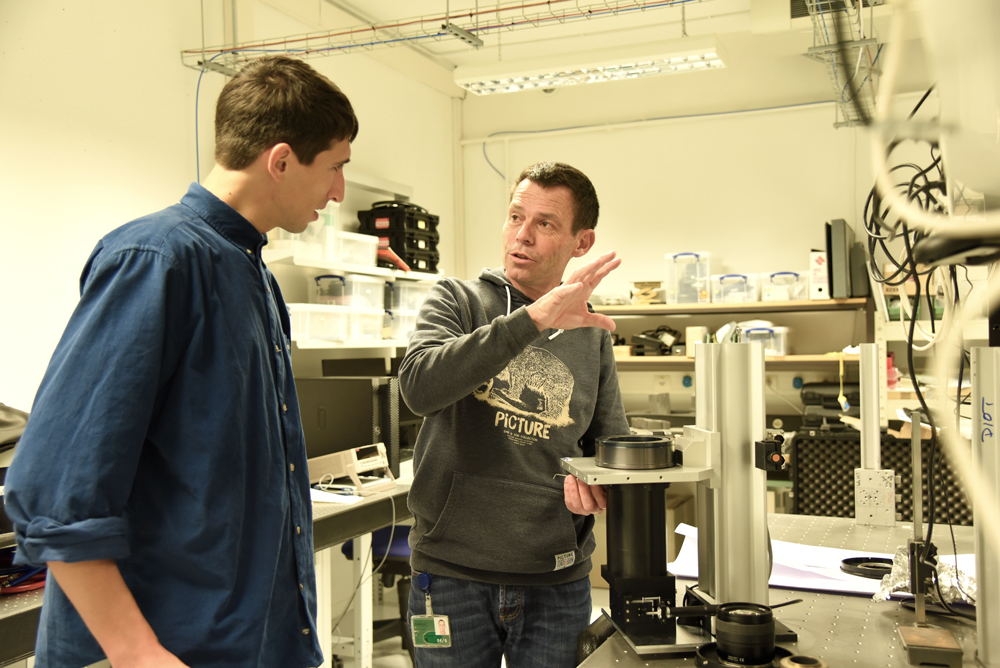From 21-25 November, BEATS beamline scientist, Gianluca Iori, was at the ESRF, the European Synchrotron, in southern France, for a busy week, meeting several groups and reviewing instrumentation for the tomography beamline at SESAME. We managed to catch him for a short interview to find out more about what he was doing. This is what he said.
Editor: The BEATS X-ray source and Front-End were installed at SESAME during the November shutdown and now installation has started on the beamline side. Can you tell us why you have come to the ESRF at this stage in the project?
Gianluca: The last few weeks have been intense in terms of beamline installation and it would have been difficult to get away before. Now, we have moved to installation on the beamline side and we are still missing several components. Some of these elements are coming from the ESRF and it was important to come to meet the experts here to gain valuable insight into the equipment, for example, mounting and cleaning procedures, operating instructions and, in the case of the sample environment, which type of furnace to choose for the beamline.
Editor: What equipment is concerned?
Gianluca: Well, I started the week in the Detector group where I met with Christophe Jarnias and Kristof Pauwels. We carried out the factory acceptance tests of the Hasselblad X-ray detector. This detector uses photographic lenses, has a medium field of view and can cover samples up to 5 cm. We tested the detector mechanics (assembly of the system, focusing stage, camera alignment stage), measured the detector optical performance (image distortion, gain, vigneting) and reviewed together the procedure to mount and clean the scintillators for this detector.
 Gianluca Iori with ESRF's Christophe Jarnias in the Detector lab. Credit: ESRF/C. Argoud
Gianluca Iori with ESRF's Christophe Jarnias in the Detector lab. Credit: ESRF/C. Argoud
 L-R: Paul-Antoine Douissard, Gianluca Iori and Kristof Pauwels in the ESRF Detector lab. Credit: ESRF/K. Colvin
L-R: Paul-Antoine Douissard, Gianluca Iori and Kristof Pauwels in the ESRF Detector lab. Credit: ESRF/K. Colvin
Gianluca: After the detector, I focussed on the scintillator mounts (of type GGG and LSO), produced by the ESRF, for the X-ray microscope. With Paul-Antoine Douissard, we went through the procedure to mount and clean these thin film scintillators for the high resolution microscope detector.
Editor: What is a scintillator?
Gianluca: Indeed, it’s not something you come across everyday. Thin film scintillators, like these ones manufactured by the ESRF, are used in synchrotrons mostly for imaging and alignment applications. They are made of inorganic crystals and they convert synchrotron X-rays into visible light. They can give a 500 nm spatial resolution equal to optical microscopy diffraction limit and, with a 200 nm optical-grade quality, they produce fully transparent, high contrast images.
Editor: Who else did you meet?
I spent quite a lot of time with the staff in the Sample Environment laboratory, especially Yves Watier, and with Pierre Van Vaerenbergh, Mechanical Engineer who has been part of the BEATS team since its inception. We followed up the work of our Master’s student Fortune Mokoena on the design of a sample furnace for X-ray tomography. We decided to go for a furnace that uses an induction heater.
We had some great exchanges here, bouncing our ideas, drawings and experience off each other. We are going to build and assemble a prototype of this furnace for BEATS in collaboration with the ESRF.
 At the ESRF's Sample Environment lab, with Pierre Van Vaerenbergh (left). Credit: ESRF/K. Colvin
At the ESRF's Sample Environment lab, with Pierre Van Vaerenbergh (left). Credit: ESRF/K. Colvin
Gianluca: My next job concerned the multilayer monochromator that will be installed at BEATS. With Ray Barret and Juan Reyes Herrera from the ESRF Optics group, we reviewed the results of the manufacturer’s factory acceptance test for the silicon substrates, simulated the beam profile and scheduled the coating of the multilayer.
Editor: Did you manage to get out and see some of the great countryside around the ESRF?
Gianluca: Well, I managed to get outside the ESRF main buildings and visit the new BM18 beamline, and of course ID19 – they are both long beamlines and situated outside the main storage ring building!
And, yes, I managed to catch-up with the BEATS team located at the ESRF and get this great group photo:
 Most of the BEATS team @ESRF, L-R: Kirstin Colvin, Alexander Rack, Michael Krisch, Gianluca Iori, Axel Kaprolat, Kimberley Robert, Jordi Bodera Sempere, Juan Reyes Herrera. Credit: ESRF/C. Argoud
Most of the BEATS team @ESRF, L-R: Kirstin Colvin, Alexander Rack, Michael Krisch, Gianluca Iori, Axel Kaprolat, Kimberley Robert, Jordi Bodera Sempere, Juan Reyes Herrera. Credit: ESRF/C. Argoud
Axel Kaprolat, the BEATS project coordinator and Pierre Van Vaerenburgh also showed me around the Chartreuse and we walked around the beautiful Monastery very well known for its Carthusian monks and their secret recipe for a warming liqueur made from many local herbs and plants.
I also found out that Axel was a great cook and got to taste some French-influenced German hospitality!
 Axel Kaprolat hosts a dinner for the BEATS team. Credit: ESRF/K. Colvin
Axel Kaprolat hosts a dinner for the BEATS team. Credit: ESRF/K. Colvin
